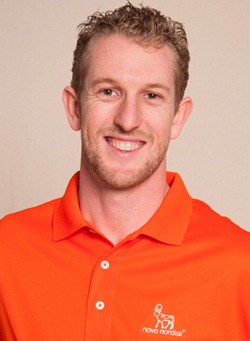Being asked for an autograph is a pretty normal thing for IndyCar racer Charlie Kimball – when he won a British Formula 3 race in 2005, he was the first American to do so in 11 years. He went on to set two track records and claim Formula 3 wins in Britain and across Europe.
So when a nurse handed him a pen after his type 1 diabetes diagnosis five years ago, he thought she wanted his autograph. In fact, she was handing him a diabetes-management tool.
Kimball, the first licensed driver with diabetes in the history of IndyCar, told MM&M that management tools, such as pens that make monitoring diabetes less of an event and more of an everyday process, help to facilitate condition management discussions. He has a lot of those with fans as he travels the country, whether on the racing circuit or with Novo Nordisk’s “Race with Insulin” campaign, which offers patients enrollment in a sweepstakes along with diabetes information.
“When you have tools like that which are so easy . . [to put] in your pocket when you’re going out to eat or carry in a purse or bag or backpack, then it’s easier to have those discussions with other people because it’s less raw and less sort of hot-button,” he explained.
The campaign includes a website, Twitter feed and an information booth at racing venues, and the competition requires that entrants build a “pit crew.” In this case, it means getting at least two other friends to sign up to win a seat at the races. Friends of the “pit crew” receive a welcome email that invites them to start a team and includes links to the Twitter feed, and the “About Charlie Kimball” part of the website that includes a video, his bio, his racing history and his schedule for the current season as driver of car #83.
The pit crew concept is central to the campaign’s tagline “Racing may have one driver, but it’s a team sport.” It’s a theme that has played out in Kimball’s experience as a diabetes patient and spokesman. He told MM&M: “When I was diagnosed, the diabetes community game me so much support and so much strength.” He wanted a chance to “repay that community but also pay it forward a little bit and try to share that message” that diabetes is a diagnosis that does not have to mean walking away from activities patients enjoy. He said it’s about understanding condition management and making a plan. For Kimball, that meant working with his healthcare team and race team to create a plan that “worked with my lifestyle as a driver.”
Kimball’s involvement also includes talking at schools, hospitals and other speaking engagements. The events are “very diabetes driven—pardon the pun,” he quips, and that despite the celebrity factor, 75% of the time is spent talking about diabetes “a higher percentage . . than I would expect,” he said, noting that his continued involvement with the campaign has shown him how many people have a personal connection to diabetes.
While Kimball is the campaign’s main attraction, the race car driver said the communal social media element is what makes the campaign effective, both in terms of providing information and moving beyond that to show what life can look like after diagnosis. He said it’s akin to seeing former NFLer Kendall Simmons (also a Novo spokesperson) or Ironman Jay Hewitt, both diabetics who are able to pursue physical challenges in addition to managing their diabetes. “It’s not easy, and you do have to make adjustments to do it differently [but] it doesn’t mean you can’t do it,” Kimball said.
He also told MM&M that he’s seen the impact of these events first-hand—a now-nine-year-old boy wrote to say he wasn’t going to see Kimball this year because he had a baseball game. He’d given up on baseball when he’d been diagnosed, but his mom said he’d changed his mind and asked to buy a glove after attending a lunch with Kimball and a group of boys between the ages of 8 and 15.
“I think a lot of people, when they are diagnosed, there is this fear factor . . it’s so easy to let it create this barrier,” he said.







